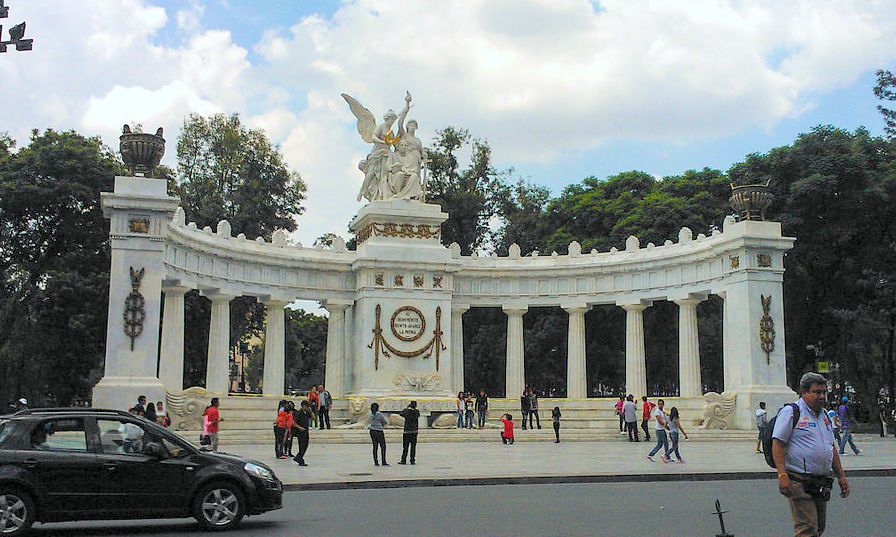
Photo: Nahid Sultan on Wikimedia Commons
The Benito Juárez Hemicycle is one of the multiple focal points of the Alameda Central. A meeting point, a prominent landmark and a historical monument, it is as Neoclassical as things get.
Semicircular, with a strong Greek influence, the monument’s 12 Doric columns support an entablature and a frieze structure of the same order. The central sculpture represents Benito Juárez with an allegorical “homeland” crowning him in laurels. The second allegory, “law” holds a torch above his head. Below, the eagle of republicanism spreads its wings on Neo-Aztec frets and a base on which two lions recline.
The central pillar medallion reads:
“To Praiseworthy Benito Juárez, the Homeland.”
Construction of the monument began in 1906 to commemorate the centennial of Juárez’s birth. Engineers were personally assigned by Porfirio Díaz, and the sculptures were completed by the Italian artist, Alessandro Lazzerini.
Dedicated on September 18, 1910, the Benito Juárez Hemicycle was the site of National Lottery drawings for decades. The same space had been the site of the Kiosko Morisco when it returned from several events abroad. When the Lottery moved into its own building, the monument became a backdrop for thousands of photos and it remains so to this day.
![]() Eastbound Turibus Historic Center Circuit buses stop opposite the monument on the Avenida Juárez, nearly in front of the Corpus Cristi Temple. Westbound buses will be north of the Alameda Central outside the Franz Mayer Museum on the Avenida Hidalgo. The walk from one side to the other takes about five minutes.
Eastbound Turibus Historic Center Circuit buses stop opposite the monument on the Avenida Juárez, nearly in front of the Corpus Cristi Temple. Westbound buses will be north of the Alameda Central outside the Franz Mayer Museum on the Avenida Hidalgo. The walk from one side to the other takes about five minutes.
 The Capital Bus tour stops across the Avenida Juárez in front of the Museum of Memory Tolerance and the old Corpus Christi Temple. From this stop, buses are returning to the Zócalo. For points to the west, passengers should cross the park to the north and board outside of the Franz Mayer Museum at the Plaza de Santa Veracruz.
The Capital Bus tour stops across the Avenida Juárez in front of the Museum of Memory Tolerance and the old Corpus Christi Temple. From this stop, buses are returning to the Zócalo. For points to the west, passengers should cross the park to the north and board outside of the Franz Mayer Museum at the Plaza de Santa Veracruz.
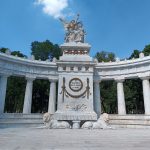 This monument is dedicated to the memory of President Benito Juárez, who defended the Mexicofrom internal wars and foreign invasions. The monument was built on one side of the Alameda Central.
Architect Heredia commissioned the sculptor Alesandro Lazzerini to complete a set of sculptures, and columns to form a semicircle of Doric columns topped by two pillars. In the center is a pair of lions and above them stands an empty tomb crowned by an eagle. In the center rises a set of sculptures depicting President Juarez seated, and behind him "The Law" and the "Goddess of Victory" crowning the president with laurels.
The monument was dedicated on September 18, 1910 by President Porfirio Diaz. It weighs approximately 70 tons and is composed of 1620 blocks of Carrera marble. The sculptural ensemble reaches seven meters in height.
This monument is dedicated to the memory of President Benito Juárez, who defended the Mexicofrom internal wars and foreign invasions. The monument was built on one side of the Alameda Central.
Architect Heredia commissioned the sculptor Alesandro Lazzerini to complete a set of sculptures, and columns to form a semicircle of Doric columns topped by two pillars. In the center is a pair of lions and above them stands an empty tomb crowned by an eagle. In the center rises a set of sculptures depicting President Juarez seated, and behind him "The Law" and the "Goddess of Victory" crowning the president with laurels.
The monument was dedicated on September 18, 1910 by President Porfirio Diaz. It weighs approximately 70 tons and is composed of 1620 blocks of Carrera marble. The sculptural ensemble reaches seven meters in height.
Heart of México Walking Route: Alameda - Madero
< < Alameda| Corpus Christi Temple > >
Proyecto “Corredor de Cultura Digital”
Nombre de la investigación: Investigación Centro Histórico, Monumentos, Edificios y Puntos de Interés (2023)
Dirección de investigación y diseño de Rutas: Acércate al Centro A.C. Guadalupe Gómez Collada
Coordinación e investigación histórica: Fideicomiso del Centro histórico Dir. Maestra Loredana Montes
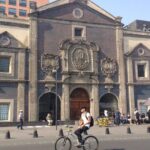
Nearest at 0.04 kms.
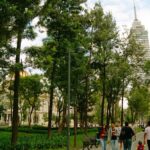
Nearest at 0.08 kms.
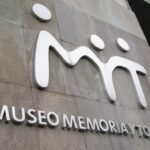
Nearest at 0.10 kms.

Among the strongest places to see historical and colonial period art works . . .

Bellas Artes has long been an iconic symbol of Mexico City's culture and performing arts.

One of Pedro de Arrieta's most lasting contributions to the look and feel of the City.
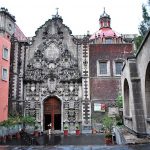
One of the oldest places on today's calle Madero, the temple is only accessible through a remaining side chapel.
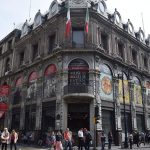
One of the most eclectic of museums, at home in one of the most dynamic of late 19th century buildings.